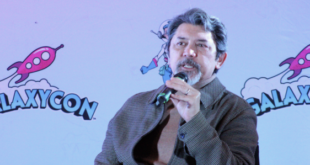
When Andrew Morgan saw the picture on the cover of The New York Times, everything within his soul revolted. Two boys his sons’ ages were strolling by a wall of missing persons signs. This was right after the Rana Plaza collapse outside of Dhaka, Bangladesh. Of the 3,639 garment workers in the factory complex, 1137 didn’t survive; others were severely injured losing arms and legs; 200 remain missing and have not been found two years later. Many agree that this was the worst disaster in the history of the garment industry. But the U.S., European, and Canadian brands that hired the factory owners to subcontract workers at a wage of around $3.00 a day were thrilled. Despite this blip and a few other disasters (another building collapse and fires killing another 1000 workers), because of owner negligence, the fashion industry was booming. Though Rana Plaza was destroyed, 2013 was a phenomenal year for the Fast Fashion industry which pulled in a record $3 trillion dollars.
In Andrew Morgan’s documentary The True Cost, we discover the ugly, monstrous underbelly of the glamorously portrayed, hyped up, shimmering fashion industry. With layered, trenchant logic Morgan shows how the cheaply priced, ubiquitously consumed, throw away Fast Fashions that are geared toward the average American customer contribute to a despoiling of the global environment, the harming and killing of garment workers and the gradual impoverishment of the US consumer. Morgan captures the gritty story on the ground with clips from river polluting leather factories in Kanpur, India, and overworked, underpaid, unprotected garment workers in Bangladesh and Cambodia, whose attempts to unionize have been met with beatings and live bullet rounds. He marshals interviews with factory owners, environmentalists from India, Indian doctors, Cambodian activists, economists, a former managing director of Monsanto India, garment industry workers who have attempted to unionize for better wages, fair trade clothing owners, sustainability activists, journalists, cotton farmers in Texas (forced to use Monsanto pesticides), and many more.

Morgan brilliantly ties how the supply chain from farmer to CEO operates with the workers and farmers at the bottom. These are the most vulnerable; they have no power or voice, and they are least able to fight for themselves. He shows in every instance that they are trod down without attention to their humanity. Considering that 40 million people are working in the Fast Fashion industry and 4 million of these are in Dhaka, Bangladesh with 85% of them women, this is 1 in 6 individuals suffering misery and privation to eeck-out around $3.00 a day, if they are lucky. It is not enough to improve their standard of living in any measurable way.

In interviews with experts, Morgan gains the witness that Bangladesh and Cambodia represent corporate heaven far from the shores of U.S. rules and regulations, 8 hour days, OSHA, litigation and, that horrific anathema, unions. The brands are not responsible for worker pensions, safe working conditions, health care, minimum wages laws, taxes, disability insurance. They are accountable to no one except their brand making money.
Through commentary by various activists, Morgan reveals the impact of the egregious attitudes of amorality and orgiastic greed by Fast Fashion brands like H & M (the second largest clothing company in the history of the industry and one of the largest producers of clothing from Bangladesh and Cambodia), Forever 21 and others. Indirectly, these brands have encouraged abuse and violence toward workers. Third world countries desperate to reap economic benefits have been seduced to the dark side by the brands’ talking points: employment rates will grow, their workers’ standards of living will rise, the economy will burgeon. Meanwhile, brands never point out the great cost that they are transferring over to the host country to “give them the privilege” of their business. Thus, when officials allow brands to contract with factory owners who put up the buildings, supply equipment and materials for workers to make clothing for pennies, it is the owners who must take full responsibility. If people die, if the soil or water is contaminated by toxic waste, the host country suffers not the brands.


Often, if the owner violates laws, he goes unpunished or they are not enforced. If there is health fallout (increased rates of cancer, deformities, disabilities), as there is with the leather industry dumping 50 million liters of toxic waste water daily (the industry uses chromium 6), into the Ganga River (area water is used for bathing, drinking, irrigation), no one is accountable. If the cancer rates have increased with increased pesticide use because the GMO Round-up ready cotton seeds are ineffective, Monsanto is not accountable. Morgan emphasizes these stunning facts about India’s agriculture and Monsanto. As Monsanto has increased its profitability by monopolizing seeds and forcing cotton farmers to buy their seeds and pesticides, India’s farmers have become so indebted they’ve lost their land and their livelihood. It is a tragic irony that with Monsanto’s attempts to improve India’s economy with its seed monopolization program, during the last 15 years, in despair, 250,000 cotton farmers have committed suicide drinking bottles of Monsanto’s pesticides. What is the true cost to the people, the culture, the environment, Morgan and his team of experts ask?
In these nations oftentimes, there is no such thing as worker’s rights, human rights, or litigation in a well constructed legal system which would provide blow back on the brands. In other words it’s a new “benign” form of slavery: the various brands’ hands and consciences’ are clean. They are not the slaveholders. They have no part of how the country sets up laws to regulate business. That way it is the factory owners who have blood on their hands, as in the case of the Rana Plaza owner who could have avoided the tragedy but was so fearful of losing his contract with a brand that he hired gangs to beat workers and force them inside the very building that workers warned was structurally unsound.

Thus, the avaricious and circular system of rapacity works against even a kind, humane owner. If, for example, an owner wants to supply a higher wage for his workers and charges the clothing brand more, the brand goes elsewhere. Brands have the money, power and mobility to relocate to another country or another factory owner with whom they can get the lowest rates and achieve the greatest profits. For them, it’s all about money. Human beings are not even in the equation, though as Morgan points out, every piece of clothing we have purchased has been touched by human hands.
The Fast Fashion industry is the second highest polluter next to the oil industry. If the fashion industry has been making trillions in the last decade with the burgeoning of advertising inspired fashions that change weekly (it used to be seasonally), then someone is getting rich. However, it is not those lower along the supply chain; it is not the American consumer who must finance moderately priced cars and important purchases, while consoling themselves that at least they can afford a lot of cheap clothing. The filmmakers ask, can they? Corporations believe they control and hold sway but their rapaciousness is an ever escalating tyranny prompting a hugely fallible business model. The fact that they have become blind, deaf, and dumb to everything but profits has made them incredibly short sighted. Indeed, they have systemically corrupted themselves into the belief that their profits in a finite world will continue to exponentially increase.

This fallacious belief cannot pertain especially if they attempt to plow down human rights in an industry that employs one in six human beings. For their amoral, negligent, and harmful actions, they are accountable. There is only so much that global cultures can take. As we are all connected, consumers are awakening and are willing to change things because they are sick of genocidal corporate mentality. Morgan reveals how this is already taking place as Fair Trade companies like People Tree are springing up and influential people like Livia Firth are engaging the help of celebrities with the Green Carpet Challenge.
Morgan’s well constructed, compactly edited documentary is one of the most important films of the year. Its message and vitality are refreshing. The film leaves one thinking about how to become an activist, how to ask questions, how to step back before buying cheap clothing to feel better, though we may never wear it and eventually throw it out. The film cautions us to think about helping our human family; our purchases have a devastating impact and in great measure, we should want to purchase brands that take social justice and human rights into consideration.
I loved this film. It is directed toward each and every one of us to open our eyes and take a stand against inhumane corporate cultures. If we are mindful about what we purchase, we will have an impact. After all, who is running the show? We are because we buy what we like and boycott what we find egregious and loathsome. Therefore, we can think, consider and engage with only those adult companies who are accountable, who are humane, who practice social justice.
You can see The True Cost on the film’s site and also see its upcoming screenings in NYC, LA, London. You may stream it on VHX, Amazon and iTunes.
[amazon template=iframe image&asin=B00Y1HD3OI]
 Blogcritics The critical lens on today's culture & entertainment
Blogcritics The critical lens on today's culture & entertainment


